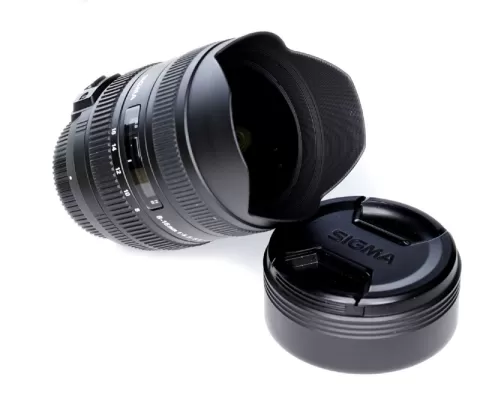My acquisition of a Sigma 10-20mm wideangle zoom many years ago was the beginning of a beautiful friendship, to quote Bogart in Casablanca. It is just my kind of lens.
I had long been casting glances towards Sigma's ultra wideangle zoom. From the moment it hit the streets. My experiences with Sigma lenses have been purely good, and I have no problem at all using third-party lenses for neither my Minolta nor my Nikon gear. The prices on the Sigma stuff is about half of that the similar original Nikkors, and even though I'm sure I'd be very happy with a Nikkor 12-24mm or 10-24mm DX, I know that I have been as happy--if not even happier--with the Sigma 10-20mm f4-5.6 EX DC HSM.
What's in a name?
Even though it's not easy to decipher, most of what you need to know about the Sigma is in its name.
10-20mm is wide. Like in really wide! It's the equivalent of a 15-30mm if we use the 35mm analogy. That is wide. The widest lens I had for my full frame film cameras was a 19mm and that was wide – not counting my full frame 15mm fisheye, but that's a whole other type of lens.
The aperture range from f/4-5.6 is not that bright. I love my f/1.8 and f/1.4 lenses, and I use Nikon's 17-55mm and the 70-200mm which are both f/2.8. You can get used to that... but f/4 and up toward f/5.6 is not that bad, particularly since it's brightest in the wide end, which I will most likely use the most.
EX can simply be read as excellent. In Sigma-lingo it actually means of superior mechanical and optical quality. And from what I've seen that's quite true. The EX lenses are Sigma's top-of-the-line products.
DC actually means DX, in other words meant for digital sensors with a DX crop factor. Since I have no plans of going full frame any time soon, this is presently not an issue for me. The lens does nicely on my D40, my D200 and my D300s.
HSM on the other hand, is an issue. The Hyper-Sonic Motor is a focus motor built like Nikon's AF-S system. Lack of HSM in third party lenses was one of the reasons I left my Minolta gear and changed to Nikon. For some reason very few Minolta lenses had HSM—or SSM (Super Sonic wave Motor) as Minolta called it and Sony calls it now—-and third party lenses rarely had a motor.
This lens could also have an IF-designation, but the people at Sigma didn't find place in the name for that. The lens has inner focusing and doesn't change size or rotate when the autofocus runs.
It also has the manual override, which Nikon sometimes calls M/A, meaning that you can grab the focus ring any time and override the autofocus. The ring will not turn when the lens is autofocusing.
So essentially this lens has everything I want from a lens.
Drawbacks
I have only a few issues with this lens, of which none are really serious, but still influence my every day shooting.
The focus direction is opposite Nikon's. Close means turning clockwise while infinity is counter-clockwise. It's not a big issue because the required focus movement is extremely small, and the few times I have missed it, the way back has been very short. Actually, the Sigma works like my old Minolta lenses in this respect, so I'm not completely confused. But of course I would prefer it to be as on my Nikon lenses.
The 10-20 also has the strangest of distortion patterns, especially at 10mm, which is where I use it most. Quite a few of my images have a horizon over water in them, and since such a horizon is supposed to be straight as a ruler, the strange curvature of the Sigma is very obvious. Unfortunately it is also very complex—not just a concave or convex curve, but more like a fancy mustache. And that makes it almost impossible to correct. I'm sure there is some third party software, which can handle it, but as it is right now, I will have to do it manually or just leave it.
My last little issue is the lousy caps and flimsy hood bayonet. The hood itself is almost OK but only attaches semi-firmly, and I have managed to break the bayonet on the lens, so now I need a piece of duct tape to keep it in pace. The rear and front caps are of a mediocre quality—in particular the front one. But using an original Nikon LC-77 cap has solved that.
Compared
I have had the chance to use the almost similar Tokina 12-24mm quite a bit, and fingered the original Nikon 12-24mm on and off a camera a few times. Both are larger than the Sigma. Tamron has a 11-18mm, which I haven't even seen in real life as is the case with Nikon's newer 10-24mm.
I always liked the Sigma best. So that was what I got.
Its compact size and the couple of extra millimeters plus that silent focusing motor won me over. In the really wide end there actually is a difference from 10 to 12mm. It's a few degrees, but when I want wide, I really want wide. I'm sure I'd be fine with 12mm, but having 10 makes me feel good.
Sigma has brought a 10-20mm f/4 to the market since then, and that would be my current choice. But since I already own the older model and I'm quite satisfied, I'll stay with that.
The lens is sharp and its colors are great. I have no major issues with any aberration or other optical flaws (apart from the distortion as mentioned, which I don't consider a major issue) and altogether the lens delivers very good images. I am sure my 17-55mm Nikkor will render a better image at 17-20mm, but since I wanted a real wide angle, the Sigma was a perfect choice.
A sweetheart lens
The Sigma is one of my true go-to lenses, and for any documentary or indoors assignments I will put it on one of my bodies and normally use it extensively.
Thanks to its wide angle it usually gives some pictures with a great perspective, and for documentary style photos it enables you to go very close and gives a real feeling of presence.
Be careful with people, though! Anything placed in the edges or in the corners of the picture will be severely distorted, and the height of the camera certainly has significant influence on the way people look. Too high and they look like large headed dwarfs and too low and they will tower over you.
The curving horizon is not an issue I worry about on a daily basis. But for certain types of landscapes, it might be a problem.
The depth-of-field is potentially very large on a lens of this type, and even at full open, the lens will be sharp from a few meters in front of the glass to the horizon.
Since Sigma has launched a new version of this lens, which is an f/3.5 all the way through, the old version is plummeting in price, and actually available for way less than I paid. At prices from lower than 300 USD used it's a bargain. The new lens sells for around 600-650 USD. I have considered upgrading to the newer version, but the old one serves me fine, duct tape and everything.
Hood gone
The hood finally took a final dive when I was shooting from my small pontoon boat over about 3 feet of water and disappeared into the not-so-abyss never to be found again. I tried getting a hold of a new one, but to no avail. A third party hood didn't work, and an original was nowhere to be found. So now my Sigma 10-20 goes au naturel.









